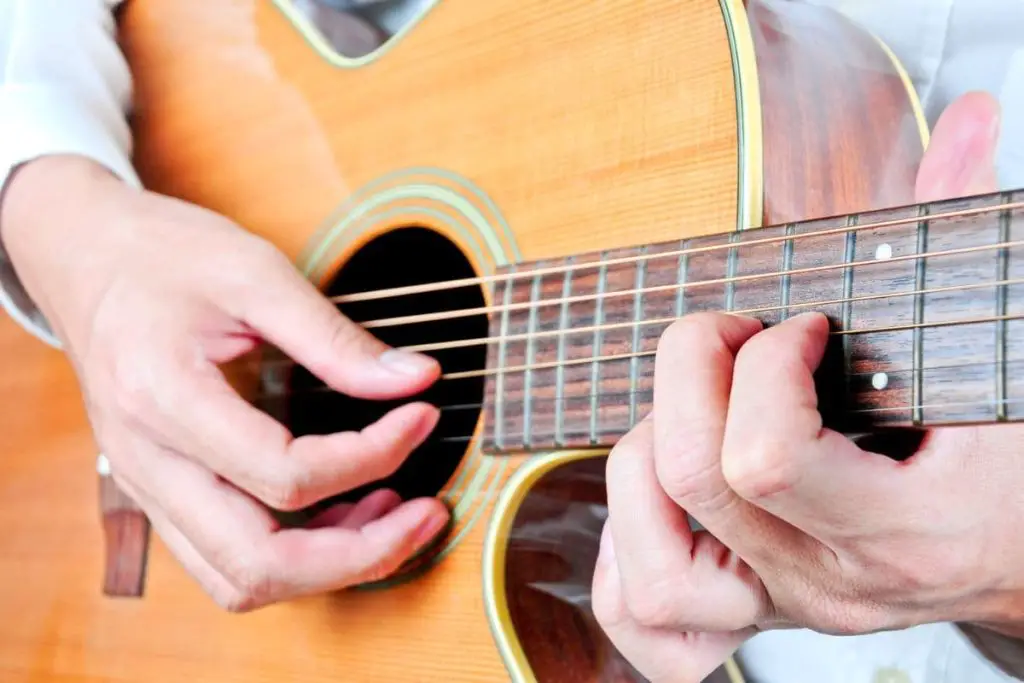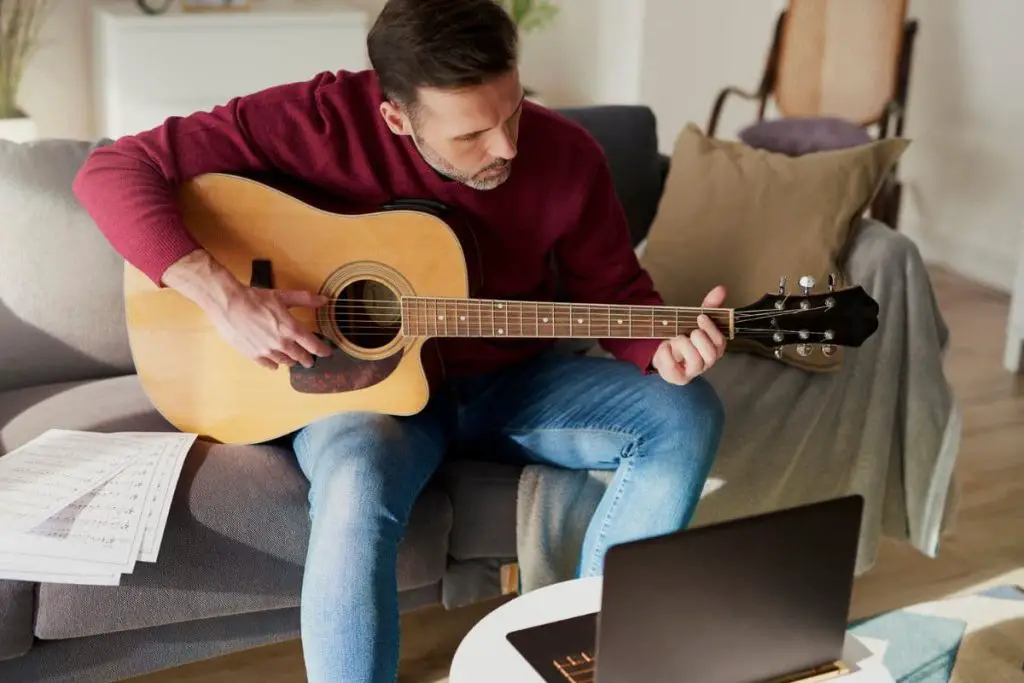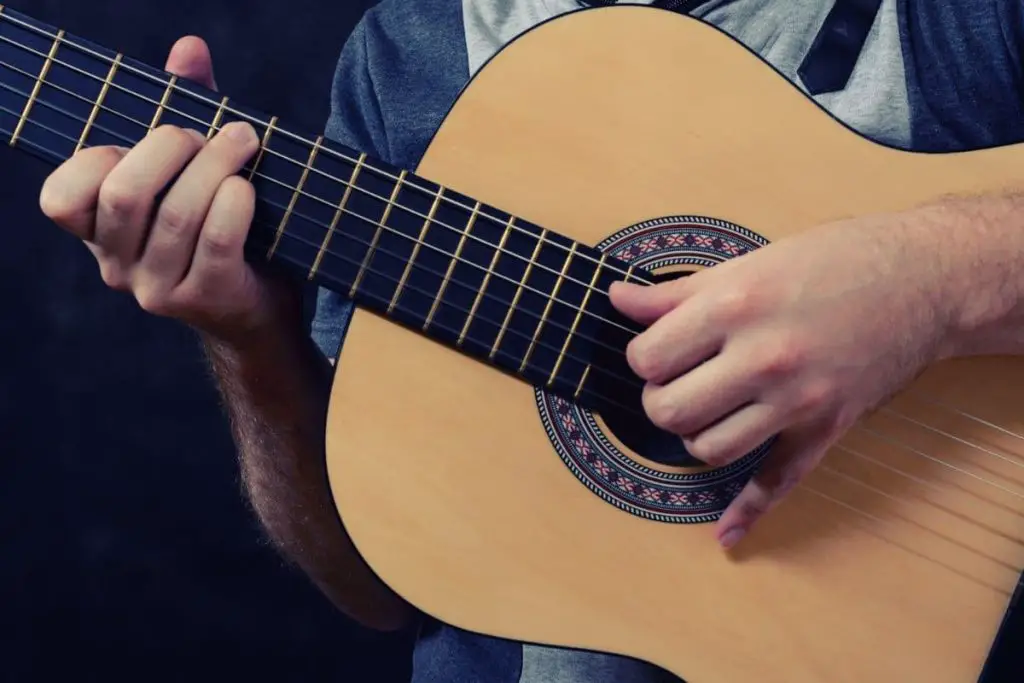Playing guitar without looking feels better, looks better, and promotes complete mastery of the instrument. If you can play the guitar without looking at the chords or strums, you know you’re on your way to being a better guitarist. However, it’s not always as easy as looking away and hoping for the best.
To play guitar without looking, it’s important to master muscle memory with your favorite chords. Learn two or three chords, then strum while switching back and forth. Once you have these chords down, only look at the strumming hand. When you’re comfortable, look away from the guitar completely.
Throughout this post, we’ll talk about the nine quickest and most effective ways to learn how to play guitar without looking. We’ll also provide a few beginner tips to make it easier for you to master your favorite chords along the way.
👇😀👇NOTE👇😀👇
If you want to find out what my recommended guitar gear is, then here is what I recommend on Amazon:
- Fender Cutaway Acoustic-Electric Guitar Bundle (MY FAVORITE GUITAR)
- Snark SN-8 Super Tight All Instrument Tuner (Easiest Tuner I’ve Used😏)
- 6 String Acoustic Guitar Capo (Best CAPO for quick changes)
- Dunlop Max Grip 1.0mm Nylon Picks (Thick Guitar Pick So You Don’t Lose Grip!)
- Universal Guitar Stand (Cheap & Minimalist Guitar Stand I Recommend)
- Levy’s 2″ Wide Quick Adjust Guitar Strap (Best Guitar Strap For Any Level)

Practice Strumming Without Chords
Chord practice is an irreplaceable part of learning the guitar, but focusing too hard on it can hinder your ability to play without looking. Since most people have an easier time strumming or fingerpicking than switching between various chords, it’s better to start your no-look journey with your strumming hand.
Here are a few tips to get started:
- Mute the strings with your left hand, so you don’t get distracted. Hearing the noises coming from the open guitar will undoubtedly make it harder to pay attention to the strumming hand. Close your eyes, mute the strings by putting your hand over them without pressing down, then strum to your heart’s desire.
- Don’t worry too much about making a perfect strumming pattern at first. You might not be able to make the same up-down pattern that you’re used to. However, you’ll eventually progress to the point where you can constantly improve your strumming and finger picking without ever looking at the guitar. Just focus on making consistent sounds.
- Once you’re ready to learn a no-look strumming pattern, try down-down-up, down-down-up. This pattern tends to be the easiest setup for people after the basic down-up method. Go slow and steady, then progressively strum faster without looking. You’ll be surprised by how quickly you get the hang of it.
Quick Note: It’s much easier to learn how to strum without looking compared to fingerpicking without looking. Strumming patterns tend to be more forgiving, so people typically won’t notice minor mistakes. There’s also less memorization for your brain when you’re strumming. Once you master strumming without looking, try a few two or three-finger picking patterns.
The most important thing about playing the guitar without looking is to make it a second-hand hobby. Repetition and constant practice are crucial. Let’s dive more into these topics in the following section.
Focus on Muscle Memory
Sound Fly explains that muscle memory is likely the most important part of playing your guitar without looking. Practice makes perfect in every area of playing the guitar. While you might want to jump right into playing the guitar without looking the second you pick it up, it’s best to practice for several hours before considering it.
However, there are plenty of ways to improve your muscle memory with your instrument. Once you get it down, you can switch to one of the numerous techniques found throughout this article.
So, how can you increase your guitar-playing muscle memory?
- Create a chord progression that you perform daily. Simple, reliable chord progressions can become automatic once you get them down. Doing these progressions daily before or after your primary practice session is an excellent way to develop muscle memory. Try C-D-G for an easy, effective progression.
- Play at least 30 minutes each day. If you don’t practice enough, you won’t get much better. Playing the guitar without looking requires constant progress and practice. You don’t need to play the guitar all day, but at least 30 to 60 minutes will help you learn the chords and strumming patterns you want to play without looking.
- Don’t worry about special playstyles any time soon. Stick to the top of the neck if possible. There’s no need to learn impressive solos and finger-picking patterns when you’re developing muscle memory. It’s better to focus on mastering the chords rather than worrying about sounding like a professional guitarist.
- Consider sticking to a schedule. Play the guitar every night or every morning. Many people believe it’s best to play instruments right before going to bed because it sticks in your memory. However, playing the guitar in the morning can be a reliable way to never miss a practice session.
After mastering muscle memory, every area of playing the guitar will be infinitely easier. You can learn new chord progressions, play with a capo, not look at the instrument, and more. If you don’t want to wait until you’re completely comfortable not looking, try the suggestion below.
Consider the Quick Look Technique
The quick look technique is a timeless practice method. Whether you’re a complete beginner or someone who’s learning new chords and tricks, it can be quite effective. You don’t need picks, capos, or anything else (unless you prefer playing with a pick).

Follow this four-step process:
- Look at your chord hand and make the easiest chord shape you can think of. As mentioned above, C, D, and G are some of the easiest chords to play with this technique. You only need to focus on two or three chords while doing the quick look technique, but you can add more complex chords down the road.
- Look away, then strum a simple down-down-up pattern. You can also strum down or up once if you’re having trouble with this method. The goal is to look at the chord for as little time as possible. Once you have the desired chord shape, look away and strum, then move to the next step.
- Switch to a new chord, look away, and repeat the steps. You can mix this step with the following subheading’s suggestion of using the frets as guidelines. Again, once you have the chord pressed, look away immediately and strum whichever pattern you think is best for the process. Feel free to intensify the pattern if necessary.
- Slowly increase the speed that you switch the chords, quickly looking at your chord hand each time. Look, chord, strum, repeat. This process might seem tedious, but it’s one of the best methods for getting your brain used to the way each chord feels. It also helps you switch between chords much quicker.
The quick look technique helps you focus on the chords while training your brain to strum without looking. It’s easier if you can master the previously mentioned strumming without looking method. If you feel like it’s getting too easy, consider only looking at the chords every two or three times you switch.
Use the Frets as Guides
The frets should be your main guide when you’re learning how to play the guitar without looking. Not only do they help you form various chords, but they also let you know when you’re increasing the pitch. The good news is that it’s nearly impossible to mess up when you’re using the guitar’s frets as guidelines.
Here’s how to do it:
- Place your index finger on the first fret of the first string. You don’t need to apply or think about any other fingers on your chord hand. It’s important to familiarize each finger with its position on the fretboard before considering chord creation without looking. This step will also improve your slides, bends, hammer-ons, and more.
- Pluck the first string without looking, then slide your finger to the second string. Don’t do them at the same time, or you’ll increase the chances of buzzing the frets. You can also strum all of the strings, though the bottom string won’t be as pronounced when you slide it up the fretboard.
- Add another finger in the chord progression (consider forming the D chord). If you want to play a D chord with this method, keep your ring finger on the second fret, bottom string. Add your middle finger to the first fret, second string, then slowly slide it to the third fret. Finally, maintain this shape and slide your index finger from the first to second string.
- Strum the guitar, then use this technique to form a new chord, such as the C chord. Without looking, place your index finger on the second string, first fret. Next, slide your middle finger from the fourth string, first fret to the second fret. Finally, slide your ring finger from the fifth fret, first string to the third string.
It’s important to start each chord from the first fret when you’re practicing not looking at the guitar.
Starting with the first string helps you learn the orientation of each string and chord without looking. Your hands will get used to the positioning, helping you know how to switch between chords with each song. Stick to a couple of chords, going back and forth before adding too many to the mix.
View this helpful YouTube guide for more details on this technique:
Try Rapid Chord Changes While Lightly Strumming
Strumming tends to be the easiest part of not looking while playing the guitar. Most people focus solely on the chords once they master strumming or finger picking. Try lightly strumming the guitar, then change between three or four chords as quickly as possible. This technique is a rapid-fire way to learn each chord when you know how they’re formed.

To make it a little bit more challenging, consider having a friend call out random chords. Give them a sheet with your four or five favorite chords, then have them choose a new chord every two or three seconds. This will ensure you don’t know what’s coming next, creating unique sounds without looking at the guitar.
For the best results, stick to the same strumming pattern the whole time. The goal is to switch between chords after two strumming cycles. For example, you could do an up-up-down-down cycle twice, then switch to a new chord. Don’t give yourself too much time between the chords, or you’ll be tempted to look.
This technique is undoubtedly harder than most of the other methods mentioned on this page. Not only are you cruising through the chords, but you’re also trying to remember where they are without looking. You can also practice this method with your favorite finger-picking style if it’s easier for you to remember.
Quick Tip: Don’t stress too much about messing up a chord or two. This training method is bound to make you skip or ruin a chord every now and then. Slow the base or increase your strumming cycles (or decrease the speed) if necessary. The goal is to remember where the chords are when you’re not looking at the guitar.
Practice One-String Hammer-On With Each Chord
Hammer-ons, slides, and other techniques can be difficult if you’re not looking at your guitar. It’s best to enhance your skills with the numerous aforementioned techniques before advancing to this method. However, it’s an essential part of playing your guitar without looking if you want to master it.
Try this quick process:
- Put your hand in a D-chord without looking.
- Remove your finger from the bottom string, pluck the bottom string, then hammer the finger back onto it.
- Repeat this process for the second and third strings in the chord.
- Once you’re comfortable with hammering each string, try hammering all of them simultaneously.
Feel free to try this technique with pull-offs, slides, and bends when you’re done with the hammer-ons. You can also advance to other chords.
This method is extremely helpful because you’ll learn where to place your fingers after pulling them off without looking at the guitar.
Focus on One Song or Chord Progression
Since muscle memory is a crucial part of playing the guitar without looking, Sound Fly suggests sticking to one song or chord progression. For example, find your favorite simple song, play it several times while looking, then try it again without looking. It’s significantly easier to play the guitar without looking when you’ve played the song countless times.

Keep in mind that if you choose one chord progression, it’s important to stick with the same strumming or finger-picking pattern. You’ll get quite comfortable with the chord progression until you don’t have to look at it anymore. When you get to this point, you can try strumming or picking the chords in different orders.
You can make this method your primary practice or do it once or twice before each practice session. Either way, do your best not to look at the instrument as much as possible. If you are accidentally looking, don’t stop playing! Just keep progressing through the song and look away. It’s better not to interrupt the flow.
Take Advantage of Adjustable Lighting
Lighting is everything when you’re learning how to play the guitar. If you can’t see the strings, you won’t be able to strum or make chords. Justin Guitar recommends dimming or turning off the lights if you want to play without looking. You’ll force yourself to learn the position of each chord. Even if you look at the guitar, you won’t really be able to see what’s going on.
Another quick trick is to keep the lights on and look at yourself playing in the mirror. This will prevent you from looking at your guitar. You’ll see and feel what the chords look like, but you won’t be able to look down until you’re done with the song or chord progression. When you’re ready, you can turn off the lights or close your eyes and try playing the guitar.
Focus on Strums or Chords
It’s much easier to focus on one hand rather than both of them. You don’t want to overwhelm yourself. If you find that it’s too difficult to focus on one rather than the other, refer to the muscle memory section. It’s always better to hone your skills before diving into not looking at the guitar while you play.
If you’re having trouble focusing on the chords, consider getting a guitar trainer. For instance, the Qudodo Guitar Trainer attaches to your guitar’s fretboard and shows you where to press. Once you know where each chord is, remove the trainer and practice each chord before thinking about not looking. While you’re doing this, keep your eyes off of your strumming hand.

Splitting the no-look method will make the process a bit easier. It’s very difficult to go from looking at both hands to looking at neither of them. See which side is more challenging, then focus on it every day until you’re ready to not look at either of them.
Final Thoughts
It’s much easier for beginners to focus on learning chord progressions, hand positions, and strumming patterns before switching to not looking at the instrument. The guitar is one of the most difficult instruments to learn without looking. However, the tips and tricks you discovered today will drastically improve your performance in no time.
👇😀👇NOTE👇😀👇
If you want to find out what my recommended guitar gear is, then here is what I recommend on Amazon:
- Fender Cutaway Acoustic-Electric Guitar Bundle (MY FAVORITE GUITAR)
- Snark SN-8 Super Tight All Instrument Tuner (Easiest Tuner I’ve Used😏)
- 6 String Acoustic Guitar Capo (Best CAPO for quick changes)
- Dunlop Max Grip 1.0mm Nylon Picks (Thick Guitar Pick So You Don’t Lose Grip!)
- Universal Guitar Stand (Cheap & Minimalist Guitar Stand I Recommend)
- Levy’s 2″ Wide Quick Adjust Guitar Strap (Best Guitar Strap For Any Level)

